Iron Cross Begonia, scientifically known as Begonia masoniana, is a remarkable and visually stunning houseplant that has captured the hearts of many indoor gardening enthusiasts. This unique begonia derives its common name from the distinct iron-like cross pattern on its leaves, making it a striking addition to any plant collection.
Origin and Background
Originating from China, Iron Cross Begonia is part of the Begoniaceae family. It’s also commonly referred to as the “Iron Cross Plant” or “Iron Cross Begonia Rex.” This particular begonia species is favored for its stunning foliage and relatively manageable care requirements.
Key Features
Let’s delve into some key features that make Iron Cross Begonia a standout choice for both beginners and experienced gardeners:
1. Unique Foliage
The most eye-catching feature of this begonia is its large, asymmetrical leaves. These leaves are dark green with a bold, silver pattern that resembles an iron cross, which is why it’s called “Iron Cross Begonia.”
2. Compact Growth
Iron Cross Begonia typically grows to a height of 12-18 inches, making it an ideal choice for smaller spaces and tabletop displays.
3. Low Maintenance
Compared to some other begonia varieties, Iron Cross Begonia is relatively low-maintenance, making it an excellent option for those new to indoor gardening.
4. Striking Red Undersides
When you turn its leaves over, you’ll be greeted with a beautiful maroon or red hue on the undersides, adding another layer of visual appeal.

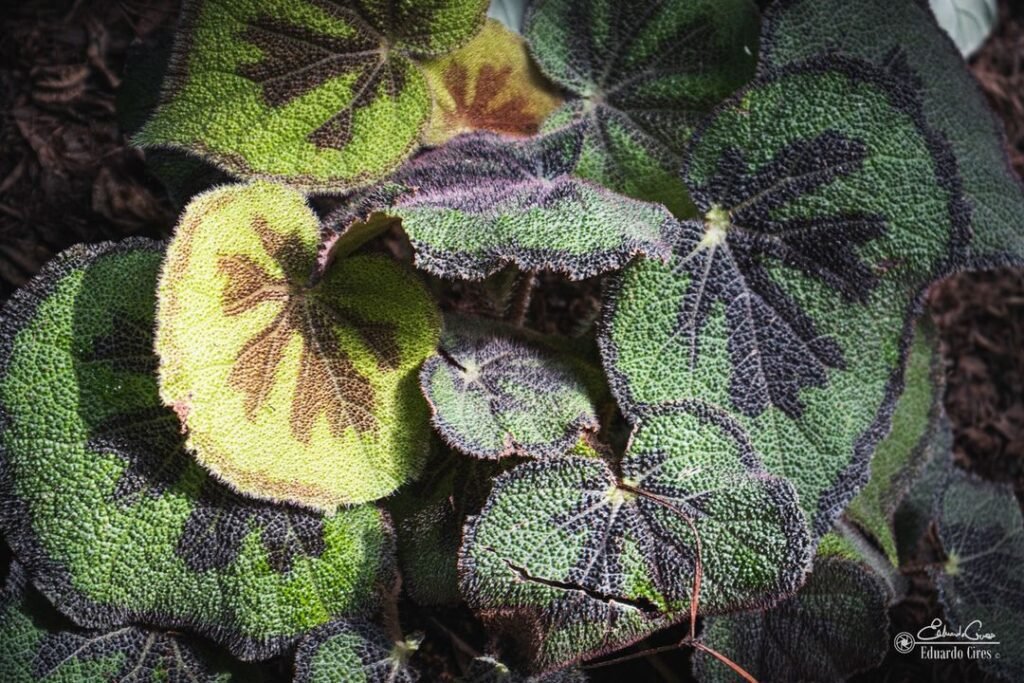
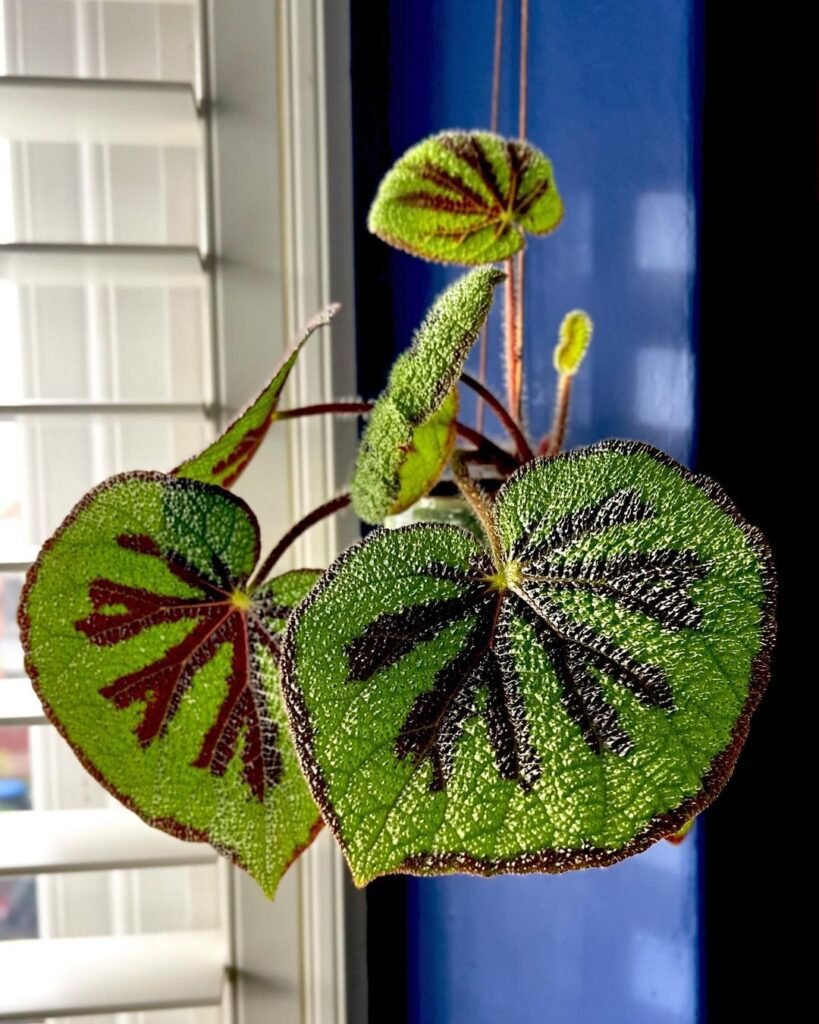
Genus Species
Taxonomy
Understanding the genus and species of your plant can provide valuable insights into its care requirements and characteristics. Iron Cross Begonia belongs to the following taxonomic classifications:
- Kingdom: Plantae
- Order: Cucurbitales
- Family: Begoniaceae
- Genus: Begonia
- Species: Masoniana
This information can be particularly useful when you’re researching care guides and troubleshooting potential issues with your Iron Cross Begonia.
Subspecies and Varieties
While Begonia masoniana is the species most commonly referred to as Iron Cross Begonia, there are subspecies and varieties that offer slight variations in leaf shape and coloration. Exploring these variations can add diversity to your indoor garden.
Varieties
- Begonia masoniana ‘Iron Cross’: The classic variety with dark green leaves and a silver cross pattern.
- Begonia masoniana ‘Variegata’: This variety features leaves with a marbled appearance, adding an extra layer of visual interest.
Subspecies
- Begonia masoniana subsp. cangshanensis: A subspecies with slightly smaller leaves and a more compact growth habit.
By understanding these taxonomic details and variations, you can better appreciate the unique characteristics of your Iron Cross Begonia.
Iron Cross Begonia Appearance

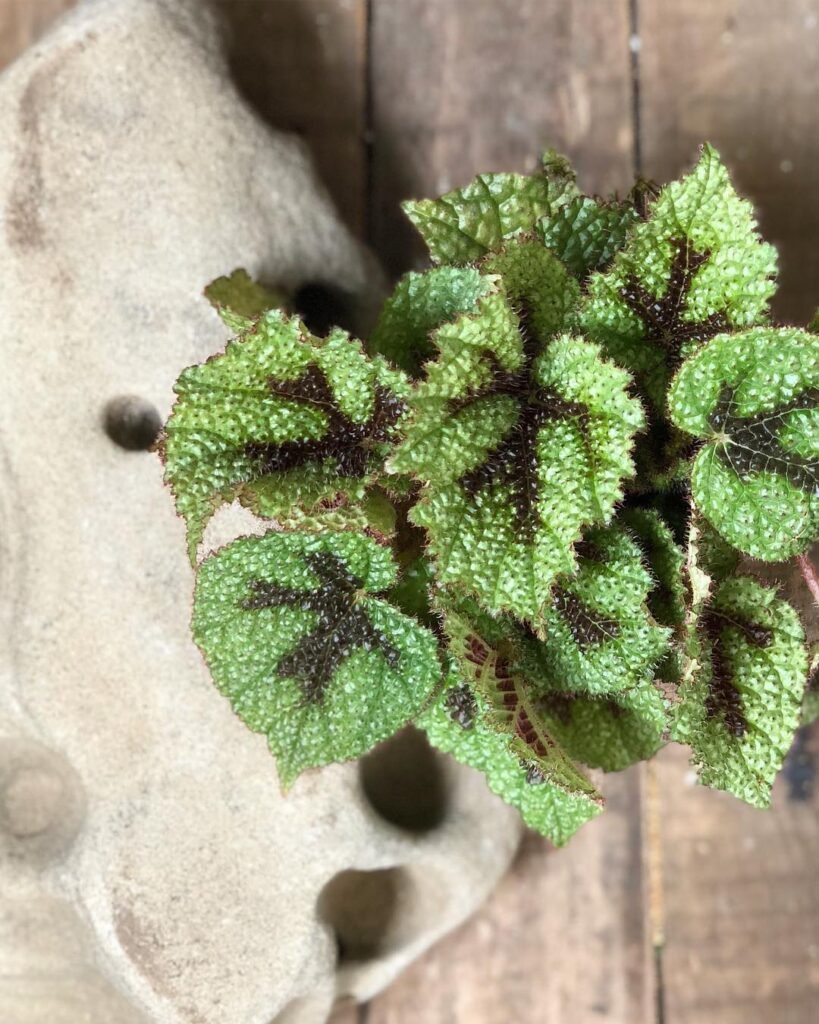
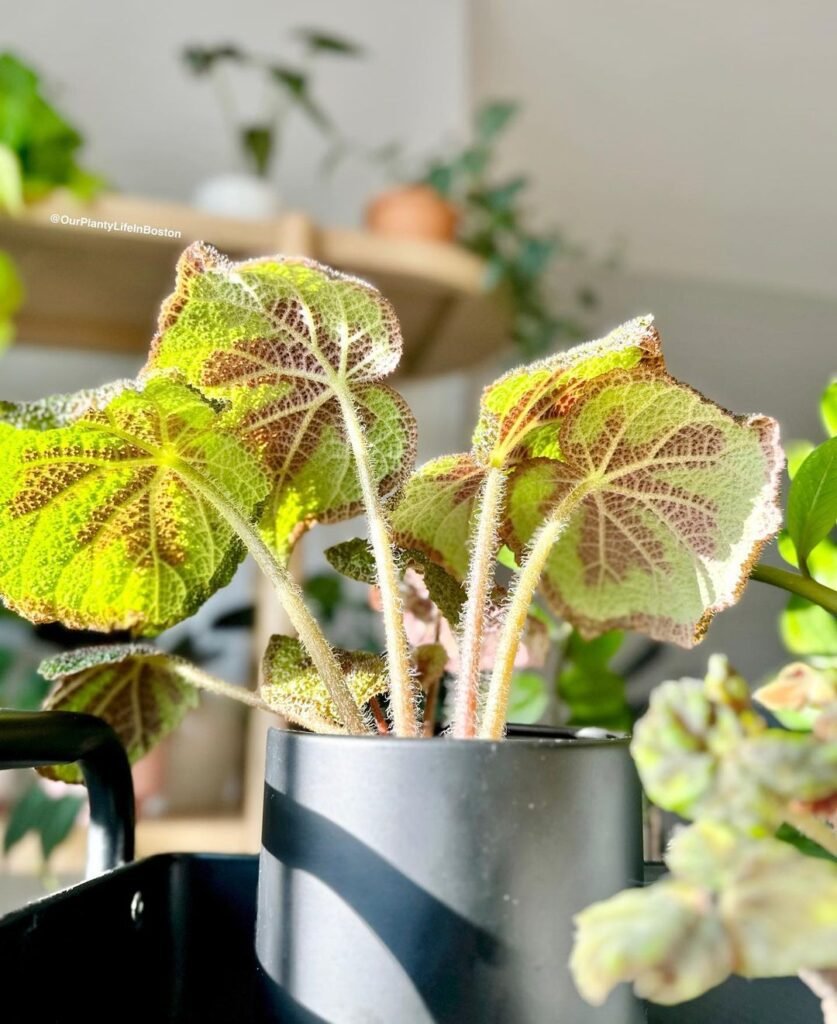
Leaf Characteristics
The appearance of Iron Cross Begonia is undoubtedly its most captivating aspect. Here’s an in-depth look at the leaf characteristics:
Leaf Size
Iron Cross Begonia boasts large, asymmetric leaves that can grow up to 10 inches in length, creating a bold and striking presence in your indoor garden.
Leaf Color
The leaves are predominantly dark green, with a metallic silver cross pattern running across their surface. This distinctive pattern is what sets the Iron Cross Begonia apart from other begonia varieties.
Leaf Texture
The leaves are textured, giving them a slightly coarse feel. This texture, along with the prominent cross pattern, adds to the plant’s overall visual appeal.
Growth Habit
Understanding the growth habit of your Iron Cross Begonia is essential for proper care and placement. This begonia exhibits a bushy and compact growth habit, making it well-suited for containers and smaller spaces.
Leaf Undersides
One of the hidden charms of Iron Cross Begonia lies beneath its leaves. When you turn the leaves over, you’ll find a beautiful maroon or red hue on the undersides, providing a delightful surprise for those who take a closer look.
| Feature | Description |
|---|---|
| Leaf Size | Up to 10 inches in length |
| Leaf Color | Dark green with silver cross pattern |
| Leaf Texture | Textured, slightly coarse |
| Growth Habit | Bushy and compact |
| Leaf Undersides | Maroon or red undersides |
Not the plant for you? Check out my full list of 78 Types of Begonia!
Iron Cross Begonia Care Tips
Caring for Iron Cross Begonia can be a rewarding experience, provided you give it the right conditions and attention. Here’s a concise overview of essential care tips to keep your Iron Cross Begonia thriving:
| Care Aspect | Tips and Tricks |
|---|---|
| Light Requirements | Place in bright, indirect light; avoid direct sun. |
| Soil Type | Well-draining, peat-based soil mix is ideal. |
| Watering | Keep soil consistently moist but not soggy. |
| Humidity | Maintain high humidity levels, use a humidity tray. |
| Temperature | Maintain temperatures between 65-75°F (18-24°C). |
| Fertilization | Feed with a balanced, diluted liquid fertilizer monthly. |
| Pruning | Trim leggy growth to promote bushiness. |
| Propagation | Propagate via stem cuttings in spring or early summer. |
| Repotting | Repot when root-bound, every 2-3 years. |
| Seasonal Care | Adjust care for seasons; reduce watering in winter. |
| Companion Plants | Pair with ferns, calathea, or other humidity-loving plants. |
| Pest Control | Keep an eye out for mealybugs, scale, and spider mites. |
| Reviving a Sick Plant | Address overwatering or underwatering promptly. |
These tips cover the fundamental aspects of Iron Cross Begonia care, ensuring that you can enjoy the beauty of this unique houseplant.
Iron Cross Begonia Light and Soil Requirements


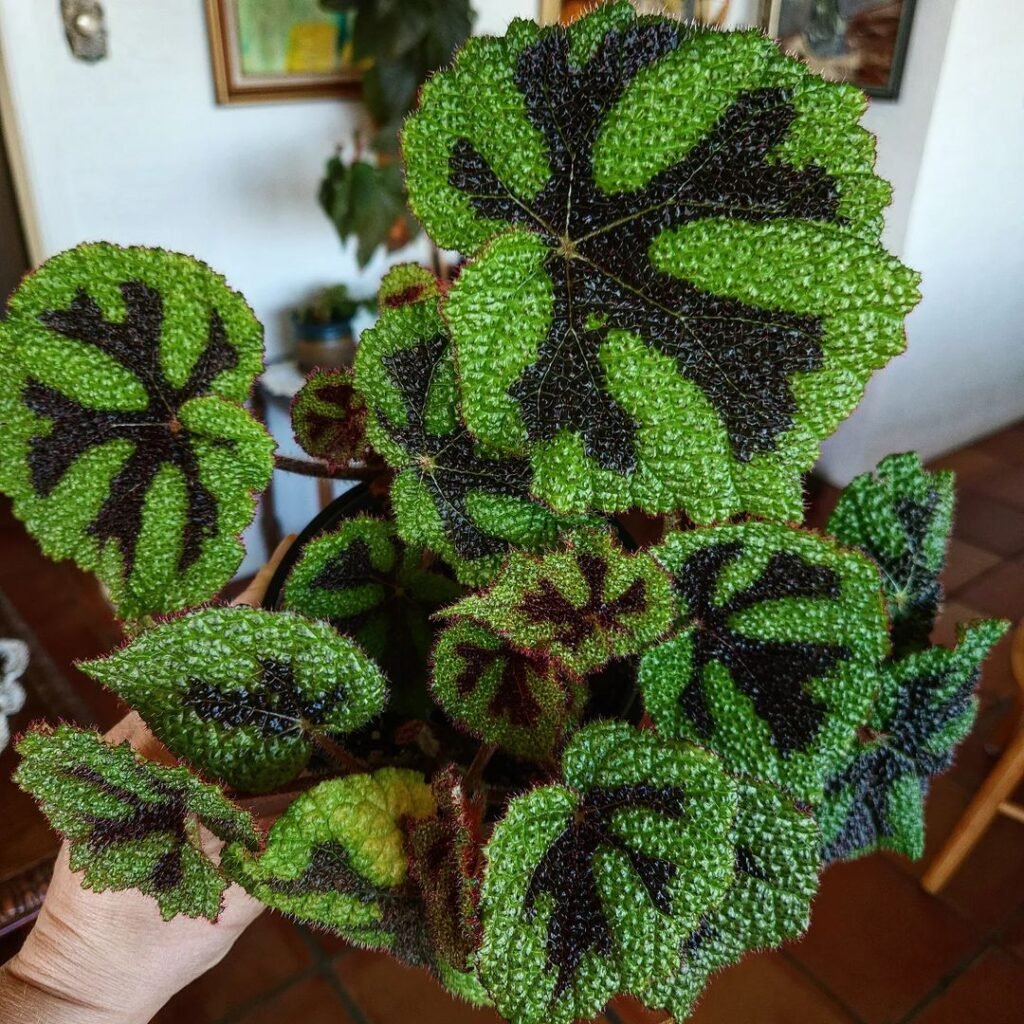
Light Requirements
Proper lighting is essential for the health and appearance of your Iron Cross Begonia. Here are some detailed insights into its light preferences:
Bright, Indirect Light
Iron Cross Begonia thrives in bright, indirect light. Avoid placing it in direct sunlight, as it can scorch the leaves. An east or north-facing window is an ideal location to provide the necessary light without exposing it to harsh rays.
Soil Requirements
Choosing the right soil is crucial for Iron Cross Begonia’s well-being. Consider the following soil-related factors:
Well-Draining Soil
The plant prefers a well-draining soil mix to prevent waterlogged roots. A peat-based mix is an excellent choice, as it retains moisture while allowing excess water to drain away.
Pot Selection
Select a pot with drainage holes to ensure excess water can escape. This prevents root rot, a common issue with begonias.
Humidity Tray
To maintain consistent humidity, you can place a tray filled with water and pebbles near your Iron Cross Begonia. As the water evaporates, it increases the humidity in the plant’s immediate environment, mimicking its native conditions.
Watering Iron Cross Begonia
Watering Frequency
Proper watering is a critical aspect of Iron Cross Begonia care. The key is to keep the soil consistently moist but not soggy. Here are some detailed watering guidelines:
Regular Checks
Frequent checks are necessary to monitor the soil’s moisture level. Stick your finger about an inch into the soil. If it feels dry, it’s time to water.
Watering Technique
When watering, pour water around the base of the plant until it starts to seep from the drainage holes. Avoid watering the leaves directly, as this can lead to fungal issues.
Adjusting for Seasons
In the growing season (spring and summer), Iron Cross Begonia may need more frequent watering. In the dormant season (fall and winter), reduce watering to prevent overhydration.
By following these watering guidelines, you can maintain the optimal moisture levels for your Iron Cross Begonia without risking root rot or dehydration.

Iron Cross Begonia Humidity and Temperature
Humidity Requirements
Maintaining the right humidity levels is crucial for the health of your Iron Cross Begonia. This plant thrives in high humidity environments, replicating its native tropical habitat. Here’s how to ensure the right moisture in the air:
Humidity Tray
One effective method to increase humidity is to place a tray filled with water and pebbles near the plant. As the water evaporates, it elevates the humidity around your Iron Cross Begonia.
Room Humidifiers
If your home has consistently low humidity, especially in the winter months, consider using a room humidifier. This can benefit not only your begonia but also other indoor plants and your personal comfort.
Temperature Range
Iron Cross Begonia is native to subtropical regions, so it prefers moderate temperatures. Maintaining the right temperature range is essential for its well-being:
Ideal Temperature
Keep your Iron Cross Begonia in an environment with temperatures between 65-75°F (18-24°C). Avoid exposing it to cold drafts or extreme temperature fluctuations, as this can lead to stress and damage.
Seasonal Adjustments
During the growing season (spring and summer), ensure the temperature remains within the preferred range. In the dormant season (fall and winter), it’s crucial to protect your begonia from cold drafts and provide some warmth.
| Aspect | Ideal Conditions |
|---|---|
| Humidity | High humidity, use trays or humidifiers if needed. |
| Temperature | 65-75°F (18-24°C), protect from cold drafts. |
| Seasonal Adjustments | Ensure temperature consistency throughout the year. |
Fertilizing Iron Cross Begonia
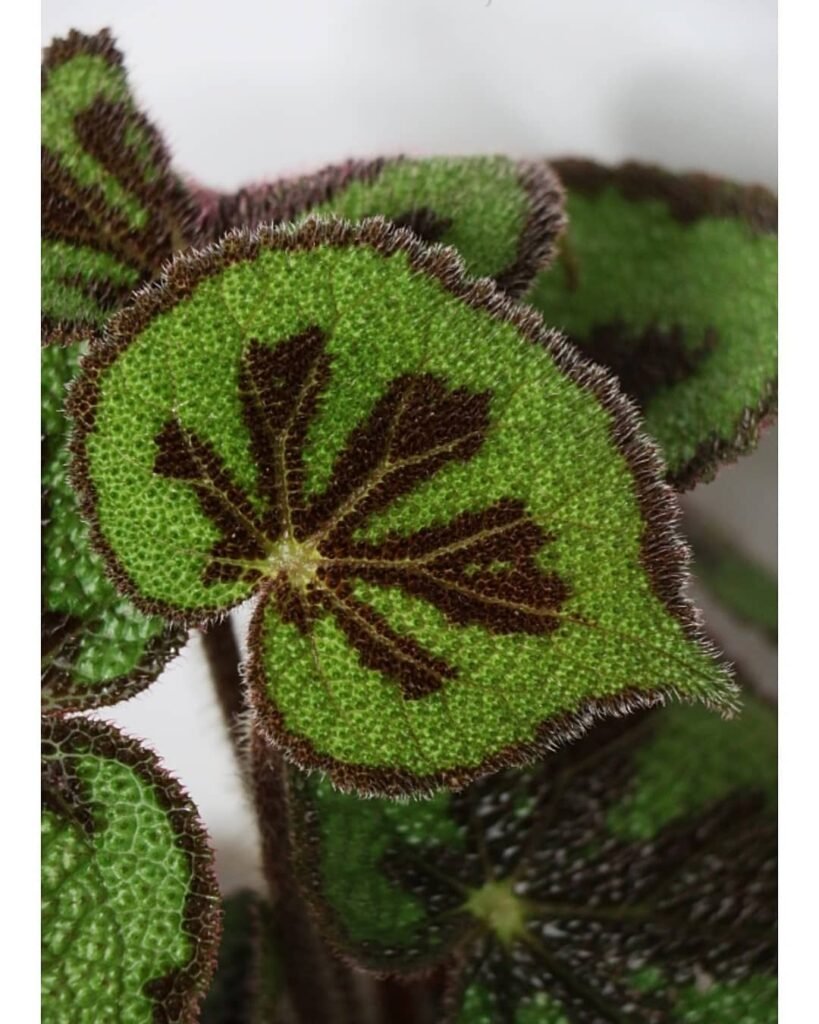
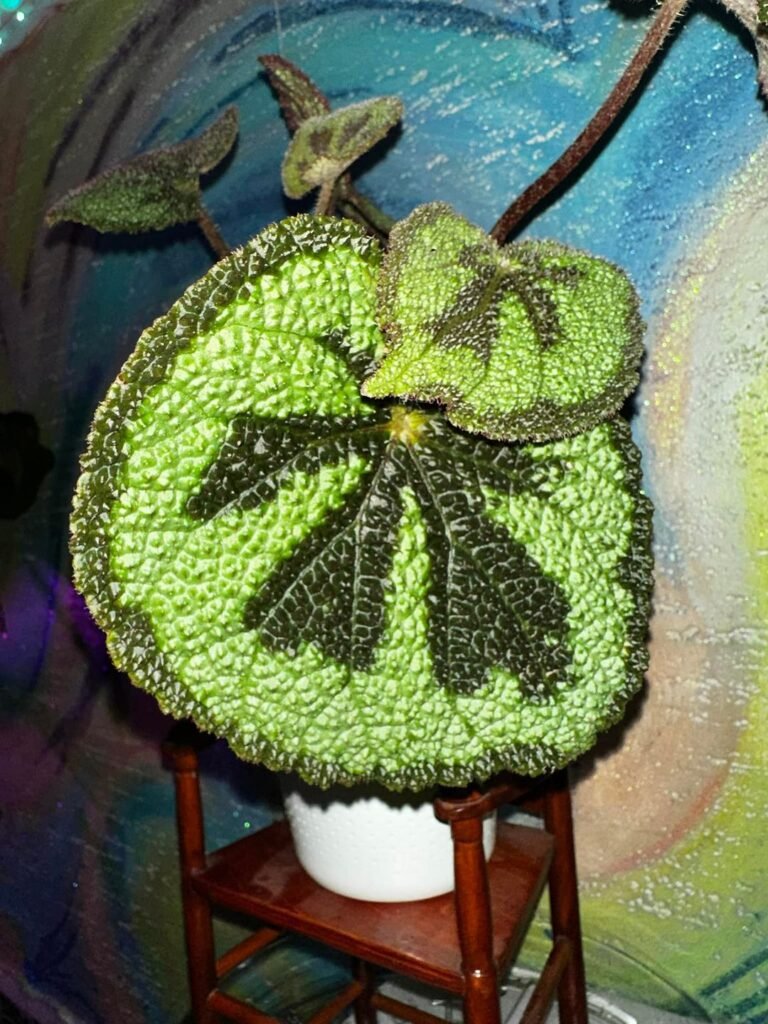

Fertilizer Selection
Feeding your Iron Cross Begonia with the right fertilizer is essential to promote healthy growth and vibrant foliage. Here are some key considerations when choosing a fertilizer:
Balanced Formula
Opt for a balanced, diluted liquid fertilizer with equal parts of nitrogen, phosphorus, and potassium. A 20-20-20 or 10-10-10 fertilizer is suitable for this begonia.
Frequency
Fertilize your Iron Cross Begonia once a month during the growing season, from spring to early fall. Reduce or suspend fertilization in the dormant season to allow the plant to rest.
Application Tips
Proper application of fertilizer can make a significant difference in your plant’s well-being. Here’s how to apply it effectively:
Dilution
Always dilute the fertilizer to half the recommended strength. This prevents over-fertilization, which can harm the plant.
Soil Application
Apply the diluted fertilizer to the soil, avoiding direct contact with the leaves. Water the plant after fertilizing to help distribute the nutrients evenly.
Avoiding Excess
Over-fertilizing can lead to salt build-up in the soil, which is harmful to your begonia. If you notice salt accumulation or signs of nutrient burn, leach the soil with water to remove excess salts.
Iron Cross Begonia Pruning and Shaping
Pruning for Bushiness
Pruning is an essential part of caring for Iron Cross Begonia. It helps maintain the plant’s shape, encourages bushiness, and removes leggy growth. Here’s how to effectively prune your begonia:
Trimming Tips
- Use clean, sharp scissors or pruning shears to avoid damaging the plant.
- Identify leggy or overgrown stems and trim them back to a node, which is the small bump on the stem where leaves or branches grow.
- Regularly check for damaged or yellowing leaves and remove them to improve the plant’s appearance and overall health.
Shaping
- Iron Cross Begonia naturally has a bushy growth habit, but you can shape it further by selectively pruning to promote a desired form.
- Consider the aesthetics you wish to achieve and prune accordingly, whether it’s a round, compact shape or a more relaxed, cascading appearance.
Iron Cross Begonia Propagation and Repotting
Propagation Methods
Iron Cross Begonia can be propagated successfully from stem cuttings. Here’s a step-by-step guide on propagating your begonia:
- Select a healthy stem with at least one leaf and a node (a small bump on the stem).
- Cut the stem just below the node at a 45-degree angle.
- Place the cutting in a container with fresh potting mix.
- Keep the soil consistently moist and provide indirect light.
- After a few weeks, the cutting should develop roots and can be transferred to a larger pot.
Repotting
Repotting your Iron Cross Begonia is essential when it outgrows its current container or becomes root-bound. Here’s how to do it:
- Choose a slightly larger pot with drainage holes.
- Prepare fresh potting mix, ideally a peat-based mix.
- Gently remove the begonia from its current pot, being careful not to damage the roots.
- Place the begonia in the new pot and fill it with the fresh potting mix.
- Water the plant thoroughly after repotting.
Remember to repot every 2-3 years to ensure your Iron Cross Begonia has ample space to grow and access to fresh nutrients.
| Aspect | Pruning and Shaping Recommendations |
|---|---|
| Pruning for Bushiness | Regularly trim leggy growth and shape the plant as desired. |
| Propagation Methods | Use stem cuttings for successful propagation. |
| Repotting | Repot every 2-3 years into a slightly larger pot with drainage. |
Iron Cross Begonia Seasonal Care
Adjusting for Seasons
Iron Cross Begonia requires different care approaches depending on the season. Here’s how to cater to its needs throughout the year:
Spring and Summer
- During the growing season, provide regular watering to keep the soil consistently moist.
- Fertilize your begonia once a month with a balanced liquid fertilizer.
- Ensure it receives bright, indirect light.
Fall and Winter
- Reduce watering frequency as the plant enters its dormant phase. Allow the soil to partially dry between waterings.
- Suspend fertilization during this period to let the plant rest.
- Protect your begonia from cold drafts and maintain a stable temperature within the preferred range.
Overwintering
Iron Cross Begonia can be overwintered indoors if you live in a region with cold winters. Here’s how to ensure its survival during the colder months:
- Place the plant away from drafty windows and heating sources.
- Water sparingly, allowing the soil to dry out slightly between waterings.
- Reduce humidity levels, as the plant is in a state of rest and doesn’t require high moisture.
By adapting your care routine to the changing seasons, you can help your Iron Cross Begonia thrive year-round.
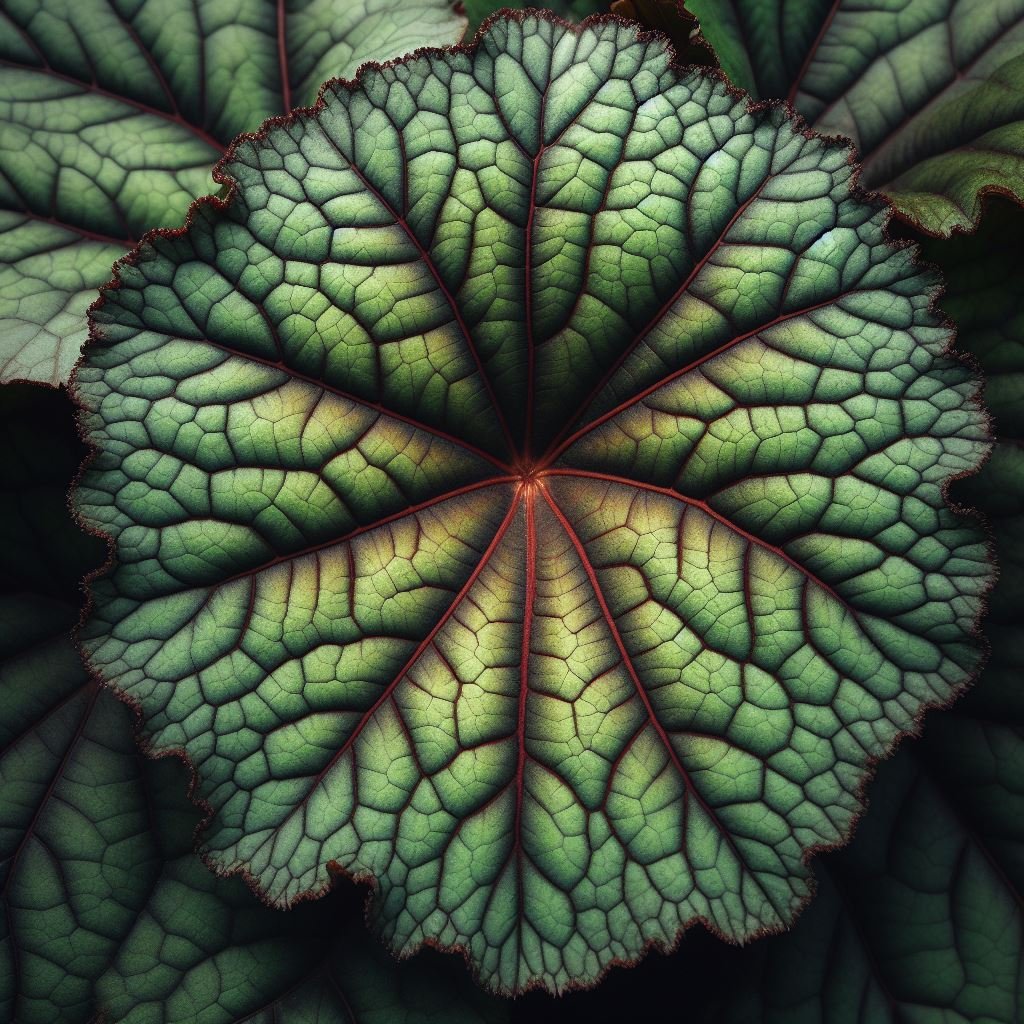
Iron Cross Begonia Companion Plants
Choosing Suitable Companions
Selecting the right companion plants can enhance the visual appeal and overall well-being of your Iron Cross Begonia. Here are some suitable companion plants to consider:
1. Ferns
Ferns, with their lush and feathery fronds, complement the unique foliage of Iron Cross Begonia. They share similar humidity requirements and can create a beautiful contrast.
2. Calathea
Calathea varieties, such as the Calathea orbifolia or Calathea lancifolia, thrive in similar light and humidity conditions. Their striking foliage patterns can make an eye-catching pairing.
3. Pilea Peperomioides
The Pilea peperomioides, commonly known as the “Chinese Money Plant,” is another great companion. Its round leaves and compact growth habit harmonize well with the Iron Cross Begonia.
4. Fittonia
Fittonia, or “nerve plant,” is appreciated for its colorful, veined leaves. It enjoys the same high humidity conditions as Iron Cross Begonia and can create an attractive contrast.
If you’re thinking of extending your begonia plant family, read up on watermelon begonia care and begonia bipinnatifida care to help you decide on the next addition to your squad.
Pest Control Tips for Iron Cross Begonia
Common Pests
Iron Cross Begonias are susceptible to a few common pests. Being vigilant and taking prompt action is essential to keep your plant healthy. Here are some tips for dealing with these nuisances:
1. Mealybugs
Identification: Mealybugs are tiny, white, cotton-like insects that cluster on the leaves and stems. Treatment: Use a cotton swab dipped in rubbing alcohol to remove mealybugs. Repeat the process as needed to eliminate them.
2. Scale
Identification: Scales are small, brown, or tan insects that attach themselves to the leaves and stems. Treatment: Gently scrape off the scales with a soft brush or cloth. You can also use insecticidal soap as directed.
3. Spider Mites
Identification: Spider mites are barely visible to the naked eye but leave fine webbing on the plant. Treatment: Regularly mist your begonia to increase humidity, which can deter spider mites. In severe cases, use insecticidal soap.
Prevention
Preventing pest infestations is preferable to treating them. Here are some tips for preventing common pests:
- Regular Inspections: Regularly inspect your Iron Cross Begonia for any signs of pests. Early detection allows for quicker, more effective treatment.
- Isolation: Isolate new plants for a few weeks before introducing them to your collection to prevent potential pest transmission.
- Cleanliness: Keep your plant and its surroundings clean, removing fallen leaves and debris where pests can hide.
By following these pest control tips and prevention measures, you can help your Iron Cross Begonia stay healthy and pest-free.
Reviving a Sick or Wilting Iron Cross Begonia
Common Issues
Sometimes, despite your best efforts, your Iron Cross Begonia may experience health issues. Here’s how to address some common problems:
1. Wilting
Cause: Overwatering is a common cause of wilting. It can lead to root rot, which inhibits the plant’s ability to take up water. Solution: Allow the soil to dry out slightly between waterings and ensure the pot has proper drainage.
2. Yellowing Leaves
Cause: Yellowing leaves can result from overwatering, insufficient light, or poor soil drainage. Solution: Adjust your watering routine, provide more indirect light, and ensure proper soil drainage.
3. Pest Infestation
Cause: Pests like mealybugs and scale can weaken the plant and lead to wilting or yellowing. Solution: Follow the pest control tips mentioned earlier to address and prevent infestations.
Pruning and TLC
If your Iron Cross Begonia is suffering, it might benefit from some extra care:
- Pruning: Trim away damaged or unhealthy growth to encourage new, healthier leaves.
- Isolation: Isolate the sick plant to prevent the potential spread of pests or diseases to other houseplants.
By identifying and addressing the underlying causes of your begonia’s distress and providing the appropriate care, you can nurse it back to health.
Conclusion
In the world of indoor gardening, the Iron Cross Begonia (Begonia masoniana) stands out as a unique and captivating houseplant, cherished for its remarkable foliage and relatively manageable care requirements. With its striking dark green leaves adorned with a silvery cross pattern, this begonia species has garnered the admiration of plant enthusiasts around the globe.
You can successfully cultivate and enjoy the elegance of the Iron Cross Begonia in your living space. Whether you’re a seasoned indoor gardener or just starting your green journey, this begonia is sure to captivate and inspire you in the world of houseplants.
FAQs
How often should I water my Iron Cross Begonia?
For Iron Cross Begonia, it’s essential to keep the soil consistently moist but not soggy. Water when the top inch of soil is dry, typically every 7-10 days, but adjust the frequency based on your specific environmental conditions.
Can I place my Iron Cross Begonia in direct sunlight?
No, it’s best to avoid direct sunlight for your Iron Cross Begonia. Place it in bright, indirect light to prevent leaf scorching. An east or north-facing window is ideal.
How often should I fertilize my Iron Cross Begonia?
During the growing season (spring to early fall), you can fertilize your begonia once a month with a balanced, diluted liquid fertilizer. Suspend fertilization during the dormant season (fall and winter).
What should I do if my Iron Cross Begonia’s leaves turn yellow?
Yellowing leaves can be due to overwatering, insufficient light, or poor soil drainage. Adjust your watering routine, provide more indirect light, and ensure proper soil drainage to address this issue.

Writer/Green Thumb/Explorer – Rooted deep in the rich soils of Devon, I’ve cultivated a vast expertise in plant care, helping greenery thrive in homes across the UK. When I’m not crafting detailed plant care guides, I’m journeying through the lush landscapes of the West Country, unearthing nature’s secrets and sharing them with fellow plant enthusiasts. Every leaf has a story, and I’m here to tell it.





